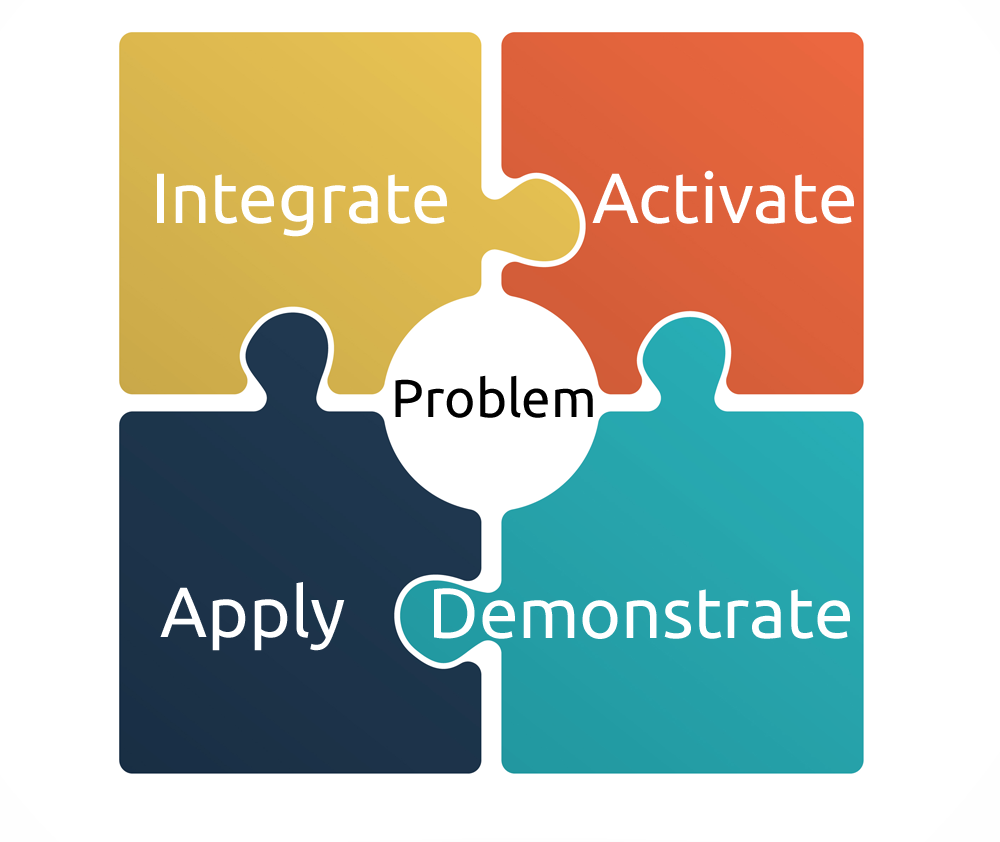As we here at ThinkingKap continue on with the Designing for The Greater Good project-course we’re trying out, this week’s module focused on designing the instructional experience.
This week, we focused on Dr. David Merrill and his philosophy, the First Principles of Instruction. The main objective for us was to create eLearning courses that follow the principles for more effective courses overall.

To design eLearning that works, you have to be able to answer questions about what the learner should be able to do once the course is completed, how the course can be more efficient, what current resources can be used to cover the topic, and how you can motivate learners to participate.
Let’s look at the First Principles of Instruction and how they answer these questions.
Problem-Centered Instruction
Problem-centered eLearning = learners solving real-world problems.
As defined by Merrill, a problem can be an array of whole-task activities that the learner will experience in his or her everyday life. This is different from topic-centered instruction (where parts of the objective are taught separately.)
The problem-centered approach works because it helps the learner see the entire problem and learn the pieces that work toward the end goal.
This method stresses the need to see the big picture for proper context.
Activation Phase
The activation phase is where learners get ready for new knowledge.
The purpose of this phase is to get the learner thinking about past experiences they can pull from when learning new information. The activation phase is important for the designer, too, because it makes him or her think about creating experience-based modules.
Merrill (2007, p. 9) suggests activation activities should:
“Direct learners to apply existing knowledge from their past experiences that can be used as a basis for the new knowledge. If learners have limited previous experience, the instruction should provide the experience that can be used as a foundation for the new information.”
Bascially, that means that if you can help learners see the lesson’s application, they’ll have more confidence in their ability to learn it. You need to provide the resources that can be used to help them organize the new data.
Demonstration Phase
The purpose of the demonstration phase is to show learners how to use skills instead of just telling them what to do.
Demonstration activities can provide a real life context to basic information, help learners maintain attention, and spark their curiosity.
Merrill (2007, p. 10) suggests demonstration activities should:
“Demonstrate through examples what is to be learned rather than merely telling information about what is to be learned.”
“Provide demonstrations that are consistent with the content being taught, including examples and non-examples for kinds-of (concepts), demonstrations for how-to (procedures), and visualizations for what-happens (processes).”
“Include learner guidance techniques, such as directing the learner’s attention to relevant information, including and comparing multiple representations, relating new information to previously recalled or provided information.”
“Incorporate media that are relevant to the content and used to enhance learning.”
Application Phase
The application phase is used to get learners actively applying their new knowledge.
This would include interactions with the content, the instructor, and peers. After a skill is taught, the learners should get chances to use the new knowledge, while also getting guidance and feedback on performance.
Merrill (2007, p. 12) suggests application activities should:
“Give learners an opportunity to practice and apply their newly acquired knowledge or skill.”
“Include application (practice) and assessment (tests) consistent with the stated or implied objectives.”
“Follow practice with corrective feedback, and an indication of progress (as opposed to just right-wrong feedback).”
“Offer learners access to help or provide coaching when they are having difficulty in solving the problem or doing the task wherein coaching gradually diminishes with each subsequent task until learners are performing on-their-own.”
“Require learners to use their new knowledge or skill to solve a varied sequence of problems or complete a varied sequence of tasks.”
Integration Phase
In the Integration phase, learners learn how to use their new skills in practical application.
For the designer, that means that if learners have information but don’t know how and when to use it, your instruction hasn’t reached its goal.
Merrill (2007, p. 13) suggests integration activities should provide:
“Techniques that encourage learners to integrate (transfer) the new knowledge or skill into their everyday life.”
“Opportunity for the learner to publicly demonstrate their new knowledge or skill.”
“Opportunity for learners to reflect-on, discuss, and defend their new knowledge or skill.”
“Opportunity for learners to create, invent, or explore new and personal ways to use their new knowledge or skill.”
Principles of Instruction: Know the Phases
Working through the phases here, you can create a course that takes a holistic approach to learning. Take your time, and work through the different course development steps that bring this process to life.
